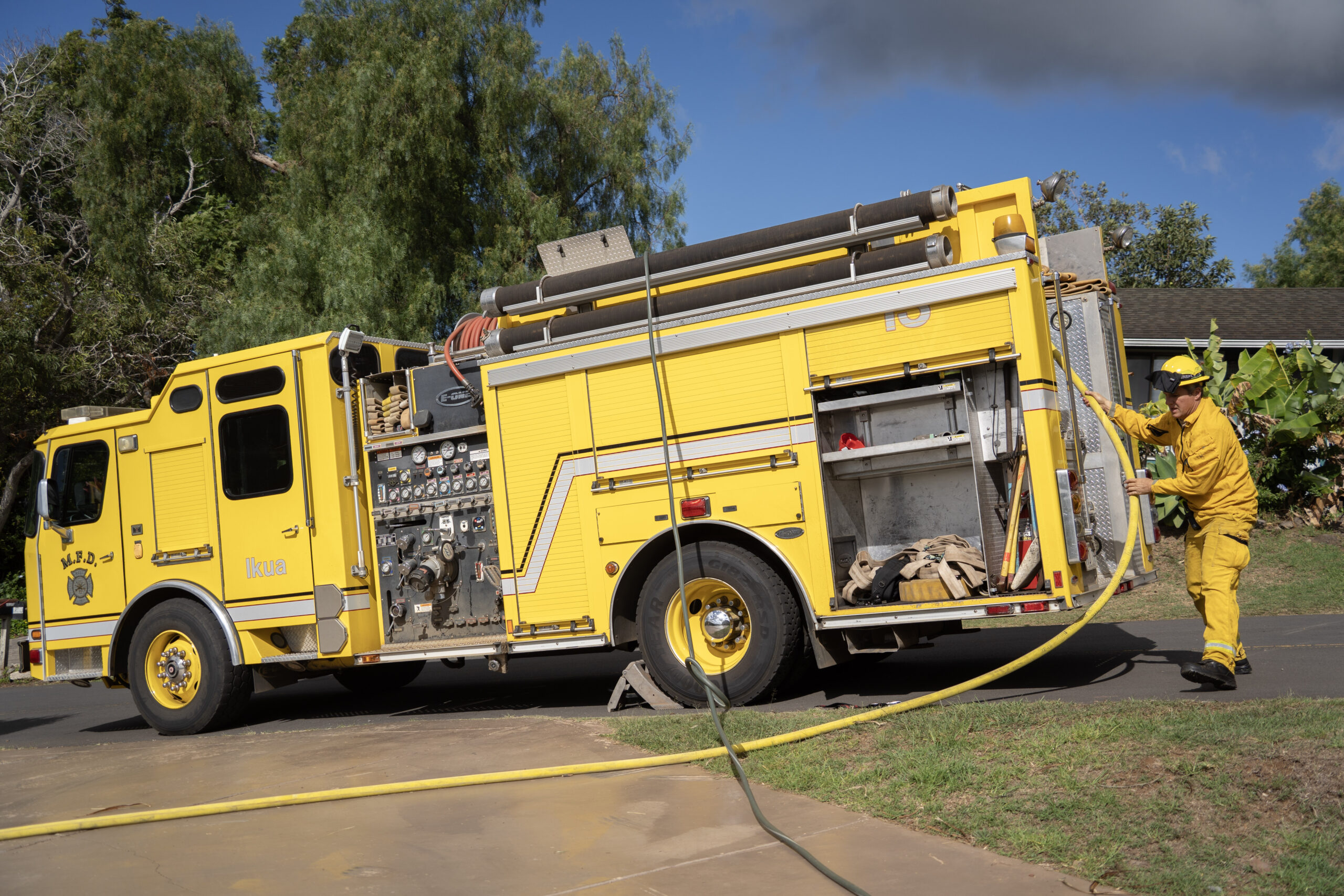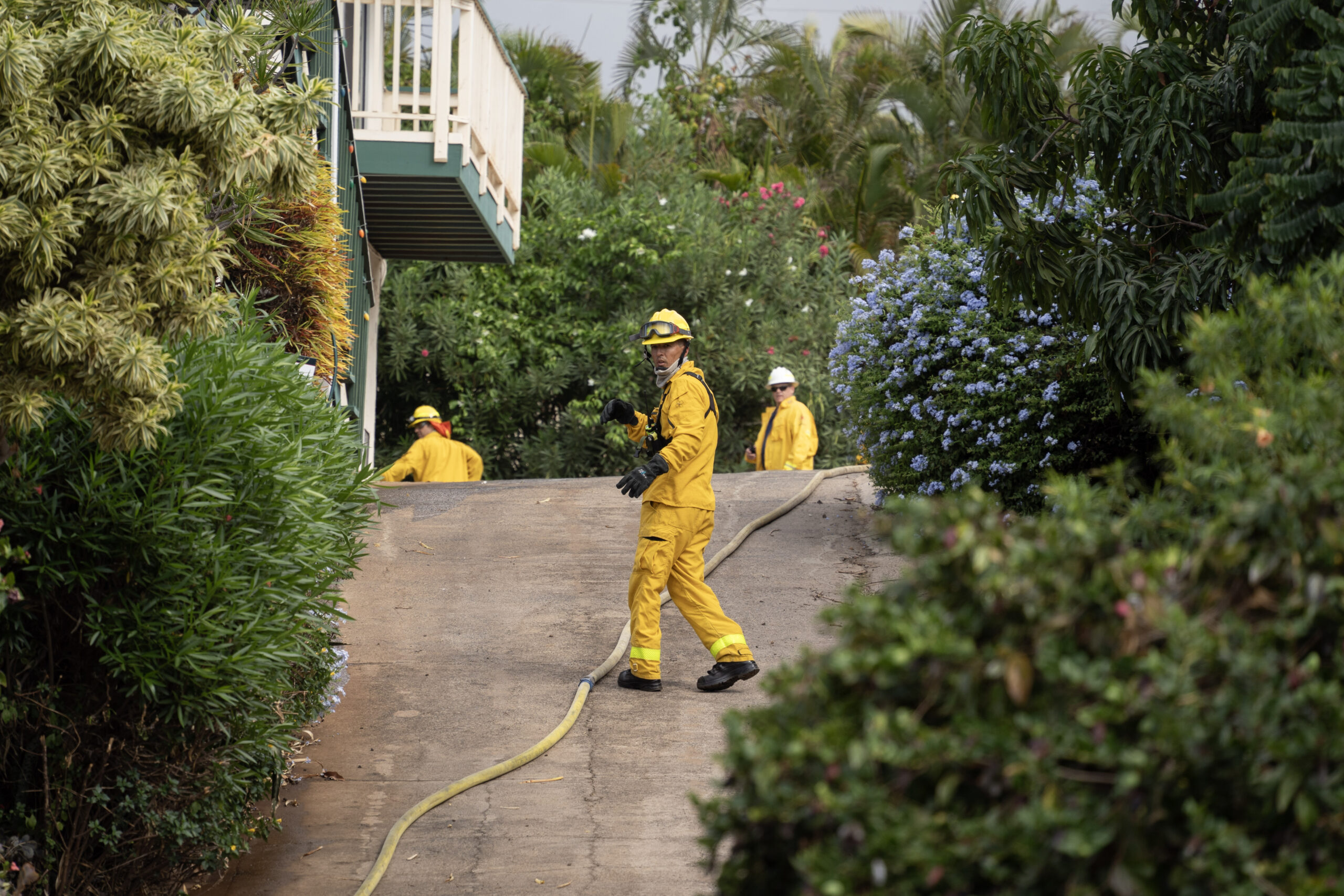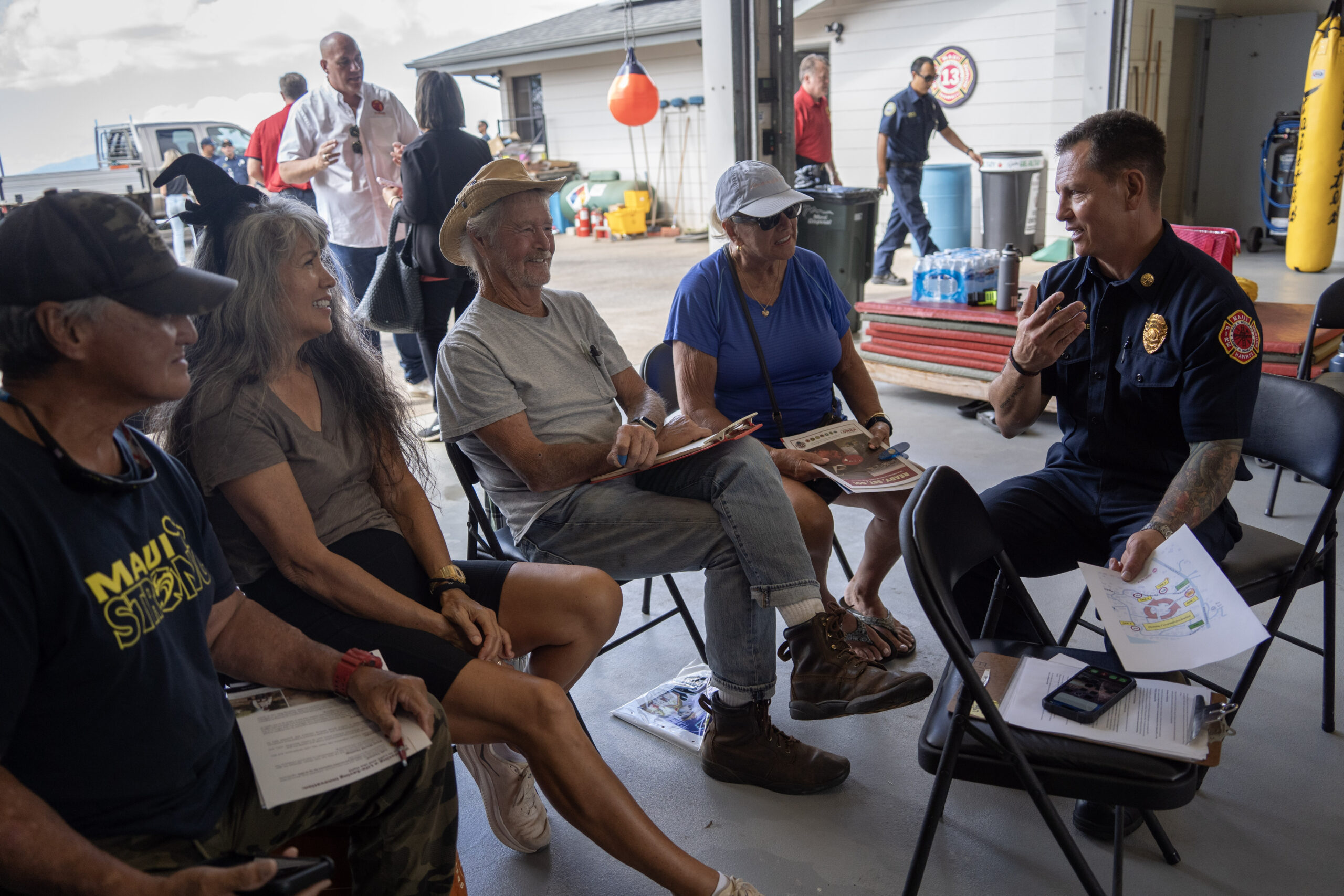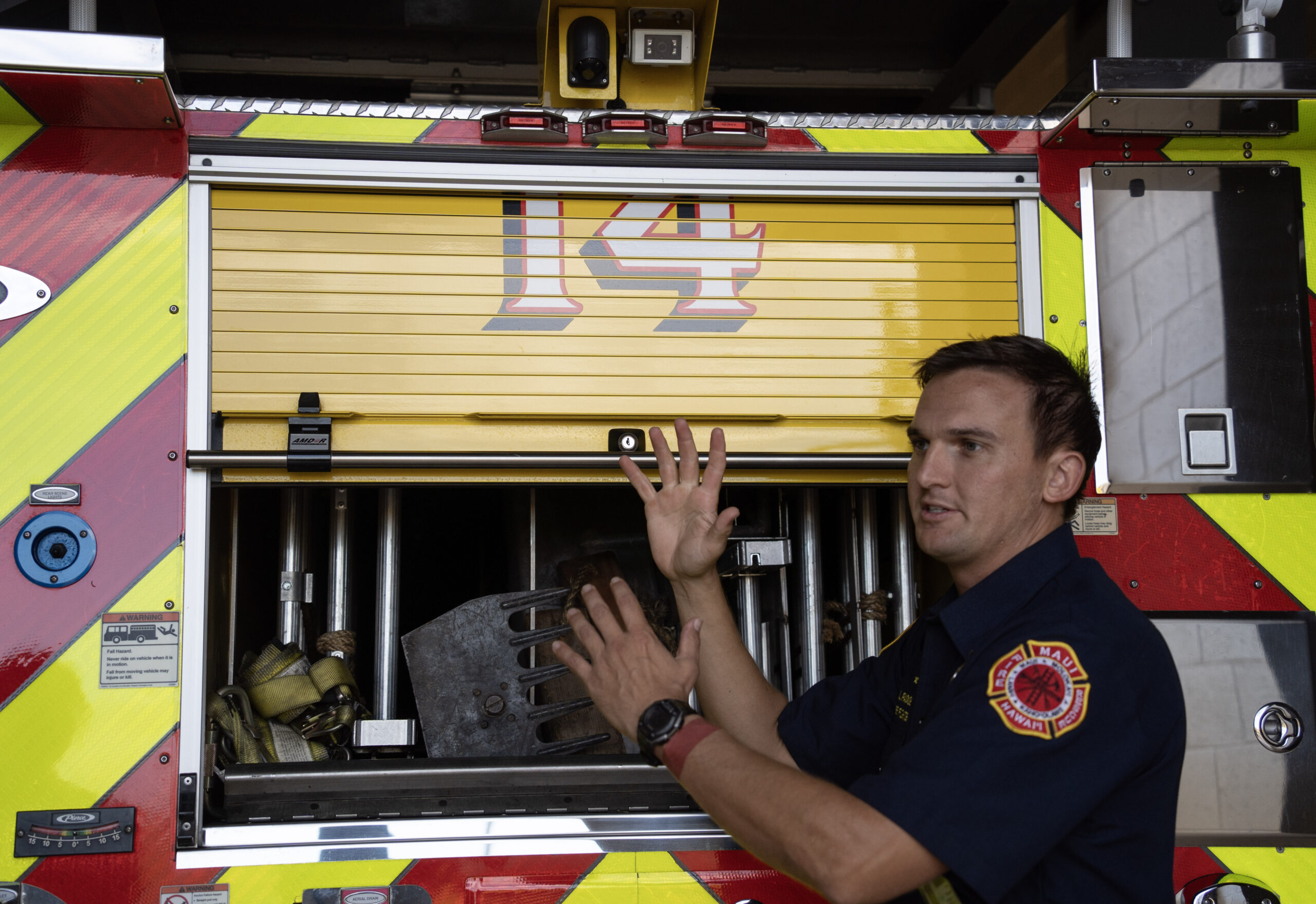Where open land meets development, Maui residents urged to view risks like a firefighter

KULA — As a make-believe brush fire raged across a Kula neighborhood, four firefighters pulled up to the driveway of a home “on fire” and hustled off the engine.
Two firefighters lugged a hose down the driveway and were spraying down signs labeled as “spot fires” when the captain on scene ran across another sign indicating that more than 25% of the roof was burning.
In the hypothetical scenario, he called off his crew. The “fire” had burned too much. They had to withdraw.
“You can spend hours trying to mop up that one fire while all the other houses around you burn, or you have to make the hard choice that too much of that house is involved. We have to write that one off,” Scott Witt, an instructor with the International Association of Firefighters, explained to the residents watching from the driveway.
Witt and other wildfire experts were on Maui last month to train with local firefighters and educate community members about what it takes to battle blazes in the wildland-urban interface, which is the area where homes and open land meet. This was the case in the destructive August 2023 wildfires in Lahaina and Upcountry.
Training programs like these were once geared primarily toward California communities who endure massive wildfires every year, said Matt Rahn, director of research with The Wildfire Conservancy. But as the risks have increased and places like Maui experience a deadly fire, the training and public outreach has spread. On Maui, the nonprofit hopes to bring firefighters and the community together on an annual basis.
“Preparedness is not just a one-time thing,” said Kelcey Stricker, health and safety director for The Wildfire Conservancy. “We’re two years out from the Lahaina fires now, and the further you get away from when a natural disaster happens, the more our memories tend to fade. So we really want to keep that constant annual interface.”
Recent fires in areas of Maui where land and development collide have highlighted the need to stay prepared. In September, a 380-acre blaze forced evacuations in Pā‘ia. On Monday, a brush fire burned 15 acres in Kapalua and led to the closure of King Kamehameha III Elementary’s temporary campus, which was built to replace the one that burned in the 2023 fire.
Maui Fire Department Battalion Chief Tim Herrick said they want the public “to understand what we are really doing when we come to your home during these fires” and to realize residents can do some of the same prep work firefighters would to make their homes defensible, such as creating space between structures and vegetation and clearing clutter from their land.
“We don’t have a whole lot of time before (the fire is) going to affect the house, so a lot of the work can’t be accomplished by us,” Herrick said.

Stricker said The Wildfire Conservancy has been working with elected officials like Maui County Council Member Yuki Lei Sugimura, whose Upcountry residents have an interest and a need for additional support and training for firefighters, and for community outreach.
The California-based nonprofit is focused on wildfire research, training and outreach. With funding from the Federal Emergency Management Agency, the organization spends about $25,000 to $30,000 to bring instructors and host training and workshops for communities, especially as the problem becomes more widespread.
In the 1970s, the total acreage burned in fires across the U.S. averaged 3 million a year. Now, it’s about four times that amount, said Rahn, who founded the bachelor of science program in wildland and urban interface firefighting at Cal State University San Marcos.
“A lot of the problems we’re facing today have to do with how we’ve historically managed our lands,” Rahn said. “But it also has to do with how we’ve designed our communities,” creating risks that are going to take a generation or more to solve.
South Maui and Upcountry were chosen for this year’s training because they were impacted by the 2023 fires — a third fire in Pūlehu forced evacuations in Kīhei, Stricker said. Different communities on Maui would be chosen for future events.
Because Lahaina is still rebuilding and is a sensitive area, Stricker said “it might be more effective to come back” once the town is repopulated.
Before going out into the community, instructors held training with firefighters in the classroom, covering safety, leadership, communications and “structure triage,” meaning evaluating a house to decide whether the home is threatened and whether it’s defensible, Herrick explained.
In Kula and Maui Meadows, a neighborhood just mauka of the Wailea fire station, residents watched as firefighters drove up to homes and received briefings from instructors.
The earliest engines on scene got ahead of the fire and assessed the structures for water sources, defensible spaces and civilians on-site, then left notes for the next crew so they would be ready to attack the fire and defend the structure.
The next crews deployed hoselines to try and protect the structure as the fire intensified. Witt placed signs in the yard — spot fires to put out, propane tanks to be aware of. But as the fire grew too strong, the crews resorted to a “tactical withdrawal,” leaving the area to let the fire front pass and returning afterwards to quickly deploy hoses, knock down fires and move on to the next house.
Witt said the approach is similar to what crews would have to do in a fire like Lahaina’s.
“The main reason that we’re operating in this manner is because we have more fire than we have fire engines, so the firefighters have to rapidly deploy, save a structure and then immediately redeploy to the next one,” Witt said. “Over the course of an hour they may hit five, six, seven structures, saving the ones that they can.”

Firefighters “want to know that the homeowner has made as much of an effort to save the house as the firefighters about to save the house,” Witt said. They want to see leaf litter and debris cleared, combustible objects covered or removed, windows closed and screens in place in case of embers.
At a home on Ainakula Road, Witt pointed to several hazards — thick ironwoods with dead material, tree needles on a wooden deck. A fire could plausibly jump from the ironwoods to the deck to the lanai to the side of the house and reach the roof, and once more than 25% of the roof is burning, firefighters have to give it up and move to saving the next home.
The Hawai‘i Wildfire Management Organization’s action guide recommends following the home ignition zone concept. The non-combustible zone, or the first 0 to 5 feet around a home, should be clear of vegetation and other combustible materials. The intermediate zone of 5 to 30 feet should be landscaped to protect against a blaze by keeping grass short and spacing out plants and trees. The extended zone of 30 to 100-plus feet should have reduced dense vegetation and be clear of dead materials to help interrupt the path of the fire and keep flames smaller and on the ground.
Some residents watched the training because they live alone and wanted to know how to better protect themselves. Others came because they’d been personally affected by fire.
Standing in the driveway of the home where the mock fire was burning, Kula resident Bill Worcester said he’s “more fire aware” after the August 2023 wildfire and a separate blaze that nearly destroyed his family’s glass-blowing studio a few months later.
The fires convinced Worcester to push for the county-owned lot next to his home to be cleared, which he said is currently underway. He said the community as a whole is much better prepared for fires.
“They’re doing the right things and it’s incredibly complicated,” he said.
It’s not easy to make entire neighborhoods resistant to fire when homes are built differently and some are more vigilant than others about cutting back their brush and keeping clutter away from their homes.
Maui Fire Department spokesperson Chris Stankis said this is “where neighbors need to talk to neighbors, and communities come up with collaborative solutions to protect the entire community.”
“These may include multiple neighbors teaming up to offer their services and assistance to other neighbors who are struggling to keep their properties up,” Stankis said. “This can be very helpful for our kupuna, who may have limited financial resources and reduced physical abilities as well.”

Mālama Kula has been working with community members to make their homes more defensible after the fire. With no curbside greenwaste pickup on the island, the nonprofit has set up four greenwaste drop-off facilities Upcountry, and it also offers curbside greenwaste pickup to Kula residents over the age of 65.
Executive Director Kyle Ellison said Mālama Kula has worked on 113 properties since the fire — some are one-time projects, others are recurring. They’ve removed about 1.3 million pounds of dead wood and fire fuels that have been turned into woodchips to help with soil retention and erosion mitigation.
“We all have to protect each other’s home,” he said. “You know, you have a fire, it moves from one house to the next house to the next house, and so if you can be the break in the chain because you’ve properly maintained your property, it can save your neighbors.”
Two years after the fire, Ellison said volunteers are decreasing, but awareness hasn’t. People still email him daily to ask if he can come check out their property. Not only does it allow him to help clear out excess fire fuels and meet his neighbors, but it also helps with spotting larger hazards on a property.
“It’s like hey, I came to pick up your one truckload of hibiscus branches, but why don’t we talk about that huge pile of dead wattle in your gulch right next to your house?” Ellison said.
Derek Barona, who lives on Upper Kimo Drive, in a home that escaped the flames by about 30 yards on Aug. 8, 2023, got Mālama Kula’s help in trimming vegetation and clearing invasive wattle trees to create a firebreak of about 30 to 40 yards from their home down to the gulch.
Barona said the community is “still aware” of the fire risks. Whenever he smells smoke, as he did during a fire a few months ago that burned down the nearby Kula Lodge restaurant, it takes him back to the horrific day of Aug. 8, 2023 in which the Kula fire destroyed 26 structures. He attended the workshop in Kula, stocking up on pamphlets about home preparation and fire prevention.

“I think people realize we’re on borrowed time until the next event,” Ellison said. “… And hopefully there isn’t another event, but if there is it would be nice to know that we tried everything possible and we did our best in between to safeguard the community.”
Backed by more funding, expanded staffing and increased fines for fire code violations that have come in response to the 2023 tragedy, Maui Fire Department’s fire prevention crews are going to be “out in the public” even more, Herrick said.
As of mid-October, the fire department had identified 46 high-risk properties on Maui, including in Wailea, Kīhei, Kahului, Wailuku, Olowalu, Lahaina and Kā‘anapali, Stankis said. Of those properties, 41 are in compliance and five are working toward compliance with the fire code.
On Moloka‘i, 49 high-risk properties have been identified, with 22 in compliance and three in the process of doing so. The other properties belong to the state Department of Hawaiian Home Lands, which is also working toward compliance.
“It’s not about fines,” Herrick said. “It’s just about getting people to (do) brush abatement. It does make a difference.”

